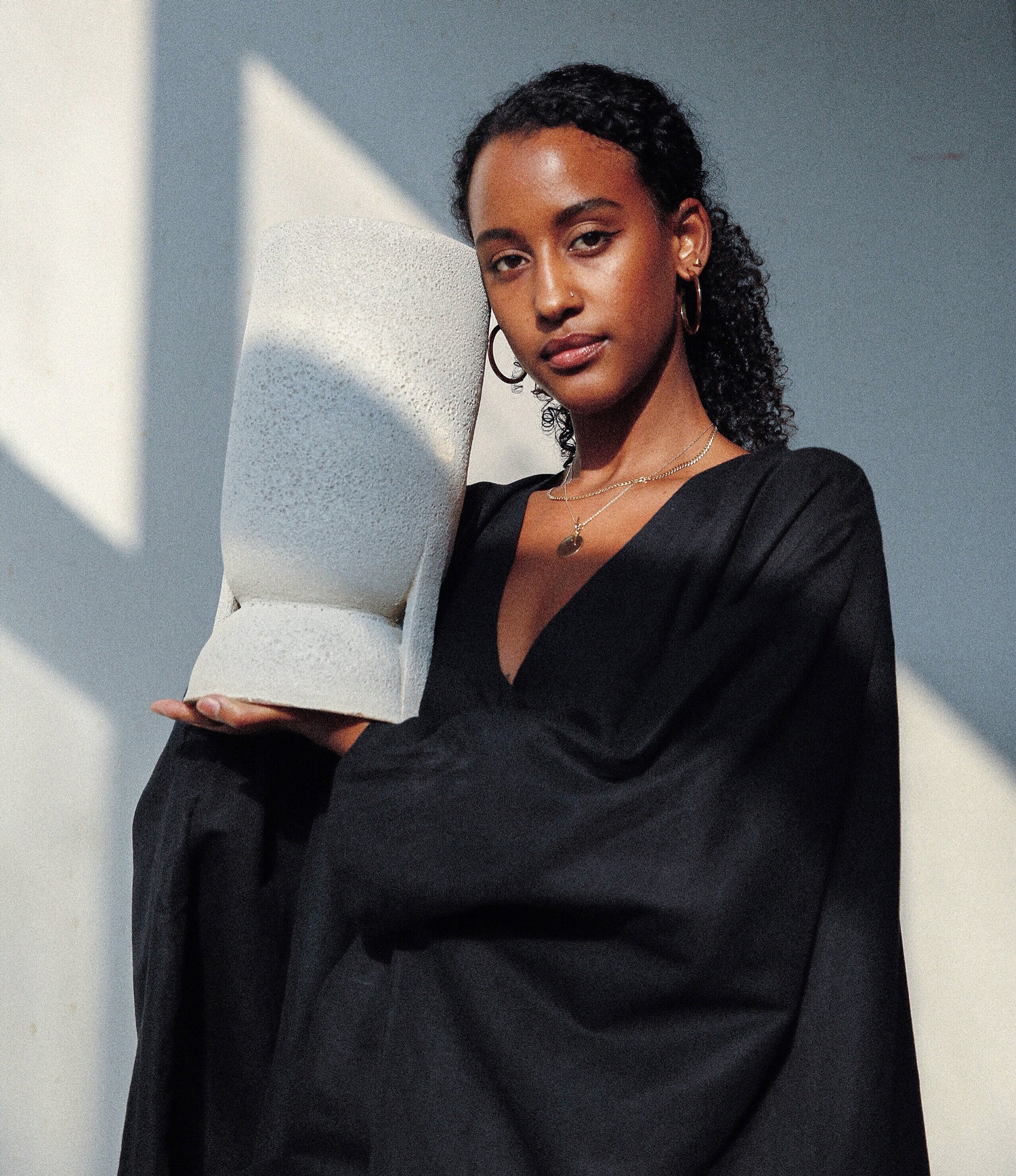
Woman Made: Dina Nur Satti
Dina Nur Satti draws inspiration from her Sudanese and Somali heritage, rooted in ideas of womanhood and community. We asked her about her ceramics
The ceramics that the US-based designer Dina Nur Satti creates in her Brooklyn studio engage with symbols and traditions from half a world away. Satti was born in N’Djamena, the capital of Chad in 1987, has Sudanese and Somali heritage, and was raised in France and Kenya before relocating to New York, taking a degree in international and intercultural studies at the city’s Fordham University.
This transnational knowledge informs her work. Her company, Nur Ceramics, established in 2016, takes its title from Satti’s own middle name, which is also a term for the Sufi concept that light can be found through one’s shadow. Creating expressive wheel-thrown and coil-built vessels in earth tones, she draws on various East African cultural traditions and natural forms—a vessel with two asymmetrical “arms” is inspired by the form of the native acacia tree, for example, while a piece with an eggshell finish makes reference to the ostrich egg motif common in Nubian and Egyptian creation myths—and she has traveled extensively through northern and eastern Africa observing the use of clay pots in ceremonies.
Satti is also one of the female designers featured in the new Phaidon book, Woman Made: Great Women Designers. In this interview she discusses her beginnings, her practice and why women designers should stand their ground.
Can you describe or characterise what you do?
My practice is a framework for self-knowing and personal and communal evolution. I think of it as a spiritual practice because it connects me to the ethereal world of creativity that is otherworldly and larger than myself. Being an artist to me truly feels like a divine experience. We work with subtle energies within our own selves and transform ideas in our minds into three dimensional expressions.
How did you get started in ceramics?
My exposure to art from when I was very young was around music. My dad had this community of painters and oud players and musicians that he was always around. I started to understand what it is to be devoted to art and what it is to communicate ideas through art. I saw people’s devotion to art, and I was always searching for that thing that was going to be my own. Eventually, that thing came and clicked with ceramics. After six months, I left my job and took my savings and decided to set up a studio. When you first start you’re dabbling with mugs and bowls, but for me, I wanted to switch very quickly into sculptures and pieces that almost help people transcend and feel like they were in an alternate space. I think it really reflects some of my own personal journey. I’m someone who loves minimalism, who loves clean lines.
How important is collaboration or the collaborative process to you as a designer?
Art doesn't exist and develop in a vacuum. Even if my audience can't see it from the outside, my relationship with other artists is a constant aspect of my journey. Being around other creatives who share your artistic worldview and exchanging ideas and experiences with them acts as a catalyst in your journey. It's an incredibly symbiotic relationship. The imperialist mind functions through divisiveness, but in order for us to continue to survive on this Earth with rising climate change and a global pandemic amidst other crises, there is a need for our core belief systems to be changed and to recognize that all beings are kin and that one cannot thrive without the other. It's also a time for us to recognize that our collective actions as a society have consequences, and what we are currently experiencing are a direct result of historically capitalist decisions stemming from these misaligned beliefs.
What is the design challenge currently giving you most pleasure?
I'm currently doing research into the ritual use of objects in indigenous cultures around the world. I think what is really fascinating is finding similarities in cultures that are very different. Additionally, there is some fascinating research around the role of women in ritual and art in pre Judeo-Christian societies. Women were the central figures who carried the practical and spiritual knowledge of art and were pivotal in the preservation of tradition and led ceremonies for the community.
Have the events of the last year signalled a change for artists in terms of gender and racial bias?
I think Summer of 2020 was a big year for many BIPOC artists in the US, and I remember for many years before that feeling like there was this glass ceiling that was there and it was only that year that I feel like that glass ceiling was recognized by the art and design community as a whole.
Who is your own personal female role model and the person you’d most like to meet and learn from?
Magdalene Odundo. It's so rare as a woman from Africa to find role models and elders who so beautifully connect indigenous craft methods and the modern design world. Dame Odundo is such an inspiration to me and I hope I have the honor to meet and learn from her one day.
What advice do you give young women designers?
That the best way to stay grounded is by staying present with what is challenging instead of trying to avoid it. Be comfortable with the uncomfortable. I think this past year taught us that. I think our society has in its DNA this conditioning to ignore what is uncomfortable and we don't encourage its members to look at their individual and collective shadows. This past year I feel like we were all forced to sit with these shadows and no longer deny their existence.